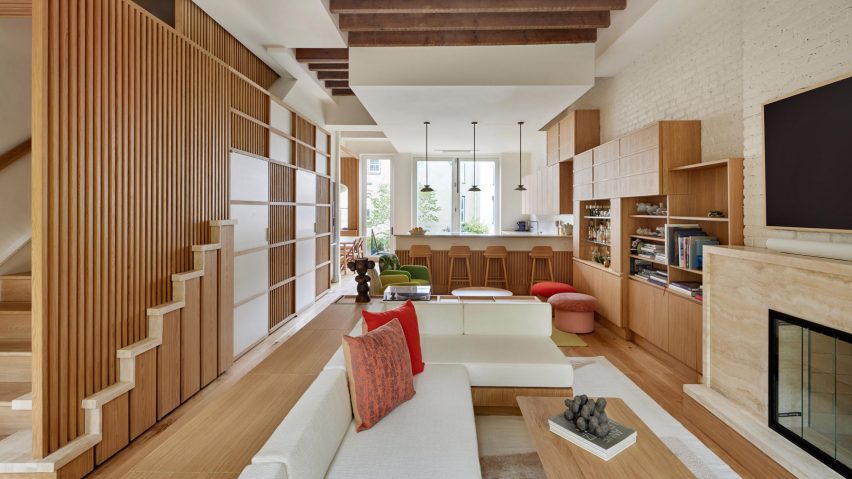New York City architecture firm Studio Vural used Kyoto merchant houses as a reference point when renovating the interiors of this Brooklyn townhouse for a couple.
A trip to the Japanese city in 2009 left such an impact on the clients that Studio Vural decided to adapt and update elements of the traditional minimalist architecture for the interiors of the Warren Street Townhouse.
"Our design is the embodiment of an early memory our clients experienced as a young couple in Kyoto, an experience so powerful and authentic, that it found its way to a new reality in Brooklyn through our imagination," said studio founder Selim Vural.
The four-storey building was overhauled to create a rental apartment at the garden level, leaving the upper three floors for the clients to live in.
With a total of 3,200 square feet (300 square metres), the project involved reorganising rooms while bringing in contemporary renditions of traditional Japanese home features, such as a sunken hearth, folding and sliding screens, and undulating soffits.
"[We] studied Kyoto houses' serene interior emptiness, flow of asymmetrical spaces, rhythm of tatami mats and the placement of courtyards to make that interpretation possible," Vural said.
At parlour level, where the main entrance is located, the plan was opened up so the living and kitchen spaces flow together.
Exposed brick walls were painted white, creating a blank canvas onto which a variety of light-toned European oak elements were placed.
The custom wooden furniture includes a window seat and a sofa. Both feature built-in storage, as well as a range of cabinets and shelves that run along one wall and incorporate a bar.
Oak boards wer also laid across the floor to create homogeneity throughout the open-plan space.
At the back of this level, the kitchen area is framed by a concrete-topped breakfast bar and includes a dining nook – based on a recessed space in Japanese reception rooms known as a tokonoma – tucked in behind the staircase.
The stairs are enclosed by slatted oak screens, and the first seven treads are widened thanks to beige limestone slabs that act as platforms for displaying objects.
Three bedrooms and two bathrooms can be found on the storey above, while a further two bedrooms and a bathroom are located on the top floor.
All of these rooms continue the same simple white and oak palette, and character is added by exposing the original wood ceiling beams.
The upper level also includes a lounge area, where the historic vertical columns are also made a feature.
Skylights were added to bring more natural light into the centre of the long, narrow space, which reaches the windowless hallway below through a glass panel in the floor.
"Our work at the Warren House Townhouse powerfully demonstrates architecture's capacity to cast distant memories into contemporary forms, revitalise historic typologies," said Vural. "It is a prime example of a historic building's rebirth for a new family in the history of Brooklyn."
Much of Brooklyn's townhouse stock has been bought up and renovated over the past few years, after homeowners jumped at the opportunity for extra space compared to nearby Manhattan.
Recently completed examples include a passive house that features a dramatic cedar screen and a project that took its architect owners 17 years to complete.
Studio Vural, which is based in the borough, has previously released images of a speculative off-grid house in the dunes of Cape Cod and a vision for a mixed-use Manhattan skyscraper covered with Asian lilies.
The photography is by Kate Glicksberg.
Project credits:
Principal architect: Selim Vural
Project architect: Rima Askin
Design team member: Angela Tsaveska
Interior design: Claire Hung Design
Engineering: Ilya Veldshteyn
Construction: David Nahm

